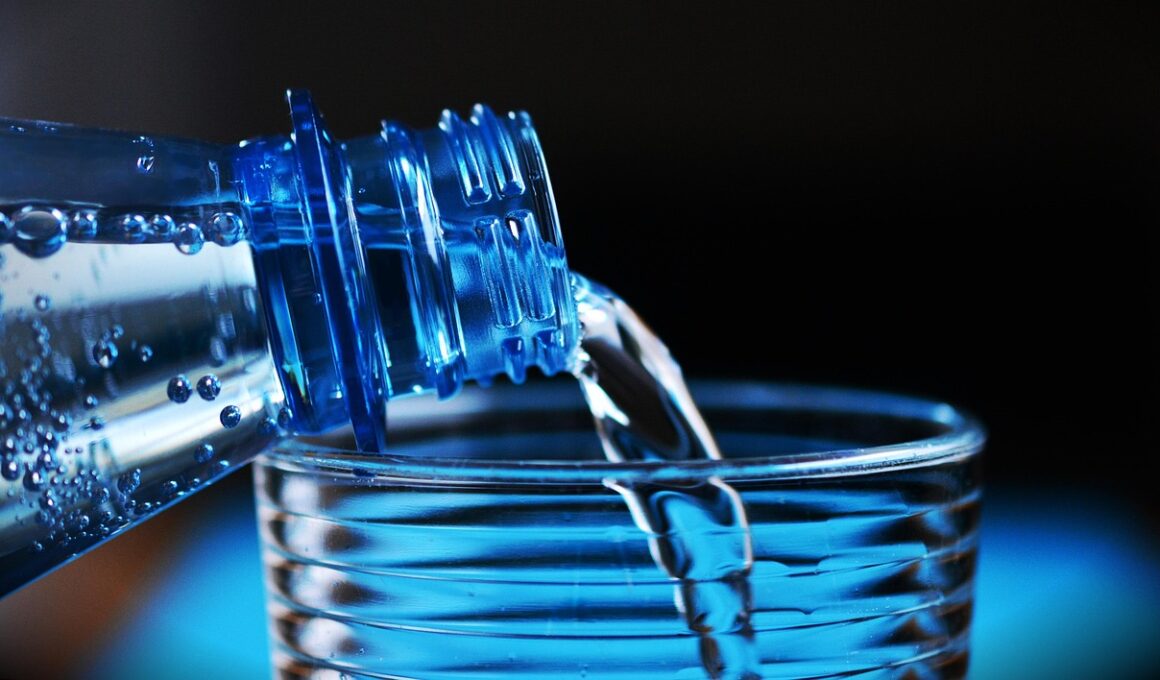Hydration and Its Role in Body Composition
Water is a vital component of our body composition, significantly impacting hydration status. The analytical methods utilized to measure body composition, such as bioelectrical impedance analysis (BIA), can yield varying results dependent on the body’s hydration level. Higher hydration usually leads to more favorable readings, whereas dehydration can skew results negatively. For those engaged in fitness and health tracking, understanding hydration’s impact is crucial. Proper hydration stabilizes measurements, promoting accuracy in assessing fat mass and lean mass. Additionally, fluctuations in hydration status due to factors like exercise, climate, or dietary changes can influence readings. These variances complicate precise tracking of body composition changes and overall health goals. This connection illustrates that maintaining daily hydration can enhance the reliability of measurement outcomes. By prioritizing adequate fluid intake, individuals can support more consistent body composition analyses, ensuring progress tracking remains credible. Furthermore, inconsistent hydration can lead to unnecessary anxiety or misinterpretation of body composition metrics. Enhanced hydration ultimately fosters realistic health assessments, paving the way for informed decision-making regarding fitness and diet. Adopting healthy hydration practices can profoundly influence measurement outcomes, contributing positively to body composition analysis.
The Importance of Hydration in Accuracy
Adequate hydration fosters improved accuracy in body composition measurements. When individuals hydrate sufficiently, the body’s water content stabilizes, which is essential for reliable readings. It’s particularly significant when utilizing technologies like BIA, where changes in hydration can directly influence resistance and reactance measurements, culminating in skewed body fat percentages. Hydrating before a measurement can help ensure that results reflect true body composition rather than short-term hydration fluctuations. This understanding emphasizes the necessity for consistent, optimal hydration levels before undertaking any body composition assessment. Accurate tracking of body fat percentage, muscle mass, and water content is essential for optimizing fitness goals. Such precision is pivotal for professionals in health and fitness fields when advising clients on body composition improvements. Maintaining water intake empowers clients to achieve precision in these assessments, leading to informed adaptations or recommendations of training regimes. Encouraging practices such as regular drinking, monitoring urine color for hydration status, and recognizing signs of dehydration can significantly aid individuals in ensuring precise measurements over time. These strategies create stronger connections between hydration and fitness results, reinforcing the integrated role both play in health improvement.
Time of day is another factor influencing hydration’s role in body composition measurement. Morning readings generally reflect lower hydration levels post-sleep. Conversely, afternoon or evening readings might present different hydration statuses, leading to variability in results. This inconsistency can hinder effective tracking across different measurement sessions. Additionally, factors like caffeine intake or sweat loss from physical activity can further complicate assessments. Managing these variables by standardizing measurement timing and conditions significantly aligns hydration status, contributing to improved reliability in results. Thus, it becomes essential to note and report the timing of assessments closely along with hydration levels. Establishing a protocol in tracking hydration before measurements is advisable. Such practices help in smoothing the variability that commonly arises from hydration fluctuations throughout the day. Enhanced reliability will permit clearer insights into an individual’s progress over time. Furthermore, recognizing the body’s hydration needs helps refine overall health strategies, whether for weight management or athletic performance. Acknowledging hydration’s impact on body composition readings promotes a holistic approach to health, allowing individuals and professionals to navigate fitness landscapes more effectively and purposefully.
Another aspect that requires attention is the role of diet in hydration status and body composition measurements. Diets high in sodium may lead to water retention, impacting body composition accuracy. Meanwhile, diets rich in fruits and vegetables not only promote adequate hydration but also support overall health. The relationship between nutrition, hydration, and body composition cannot be overstated. Nutritional behaviors directly affect body water levels and can manifest in variations in measurements due to suboptimal hydration. Practical dietary guidelines suggesting higher water-rich foods are invaluable for achieving optimal hydration status. Hydrating foods like cucumbers, watermelon, and oranges can naturally enhance fluid intake. These foods can become integral components of a diet aimed at improving body composition measurement accuracy. Education on the connection between diet, hydration, and precise body composition assessment should be a priority in fitness and health programs. By fostering an understanding of this complex interplay, individuals will be better equipped to pursue their health goals effectively. Ultimately, strategizing dietary choices to align with hydration needs highlights the multidimensional impact of holistic health approaches on body measurement outcomes.
Leveraging Technology for Hydration Awareness
Modern technology plays a pivotal role in monitoring hydration levels and improving body composition measurement accuracy. Smart water bottles and hydration tracking apps have become increasing popular among fitness enthusiasts. These tools can send reminders to drink water at scheduled intervals throughout the day. By encouraging continuous hydration awareness, these applications help individuals stay consistent with their hydration goals. Adopting technology means people can receive real-time feedback on their hydration habits, making adjustments simpler. This level of accessibility enhances accountability and fosters a stronger relationship with hydration practices. Moreover, by gathering data on hydration habits, individuals can correlate their fluid intake with body composition measurements over time. This correlation can lead to significant insights about personal hydration needs and the resulting impact on fitness progress. Technology can also facilitate knowledge sharing, allowing individuals to connect with experts in nutrition and fitness. These connections can yield valuable support and share personalized hydration strategies. Strategically leveraging these technological advances ensures that hydration status becomes a focal point in tracking body composition changes, illustrating the modern intersection of health and technology.
Additionally, it’s essential to understand how different types of hydration affect body composition assessments. Not all fluids contribute equally to hydration; for example, sugary beverages can cause fluctuations in blood sugar and body fluid distribution that mislead body composition results. Emphasizing water as the primary source for maintenance is crucial. Such information is vital when advising individuals on optimal hydration practices. Water serves as the most effective fluid for maintaining stable hydration levels, crucial for accurate assessments in body composition analysis. Educating individuals about optimal hydration types enhances their ability to navigate hydration choices effectively. Moreover, a better understanding of hydration variations makes it easier to internalize the importance of consistent water intake versus fluid consumption from other sources. Fundamental hydration education can significantly improve overall health strategies and assist individuals in creating a clearer pathway toward achieving fitness and health goals. This knowledge transforms perceptions of hydration from mere routine to an indispensable practice within body composition tracking and health management.
Conclusively, an integrated approach to hydration and body composition analysis is crucial for achieving reliability in measurements. Stakeholders in fitness, including trainers and nutritionists, should emphasize the importance of hydration in any health improvement program. Through educating clients about hydration norms and their influence on body composition, professionals empower clients to make informed decisions. By adopting a systematic strategy, individuals can optimize their hydration practices and improve the accuracy of body composition evaluations. Accurate measurements correlate directly with achieving fitness goals effectively, creating a more informed environment for program adjustments and outcomes. Encouraging consistent hydration practices can lead to significant improvements not only in measurement variability but also in participants’ motivation for their health journeys. Collaboratively, as expertise in hydration and body composition unfolds within health communities, a stronger foundation of knowledge can support mutual growth. Reinforcing hydration as pivotal in health tracking shapes a comprehensive understanding of achieving personal fitness aspirations. Ultimately, this holistic perspective transforms how we approach health monitoring and emphasizes the vital interaction between hydration and body composition, promoting overall wellness.
With continued research, the connection between hydration and body composition is poised to evolve. Emerging studies will likely provide deeper insights into individualized hydration strategies and their effects on overall health metrics. Evaluating hydration and body composition in tandem will foster more robust health guidelines. By aligning water intake with body composition measurements, a clearer picture of fitness and health can emerge, empowering individuals on their health journeys. This knowledge lays the groundwork for future explorations, reinforcing the necessity of integrating hydration practices into everyday routines. The pursuit of improved body composition metrics will remain a significant focus, leveraging hydration as a core element in this process. As understanding deepens, communities can harness this information to foster healthier choices. Thus, the synergy between hydration, body composition, and wellness practices will become an integral component of holistic health. Knowledge and careful application are crucial in advancing understanding within this realm. Future initiatives may revolve around reinforcing the essence of hydration in fitness discussions. The impact of adopting informed hydration strategies in supporting accurate body composition outcomes deserves recognition in the fitness and health spheres.


